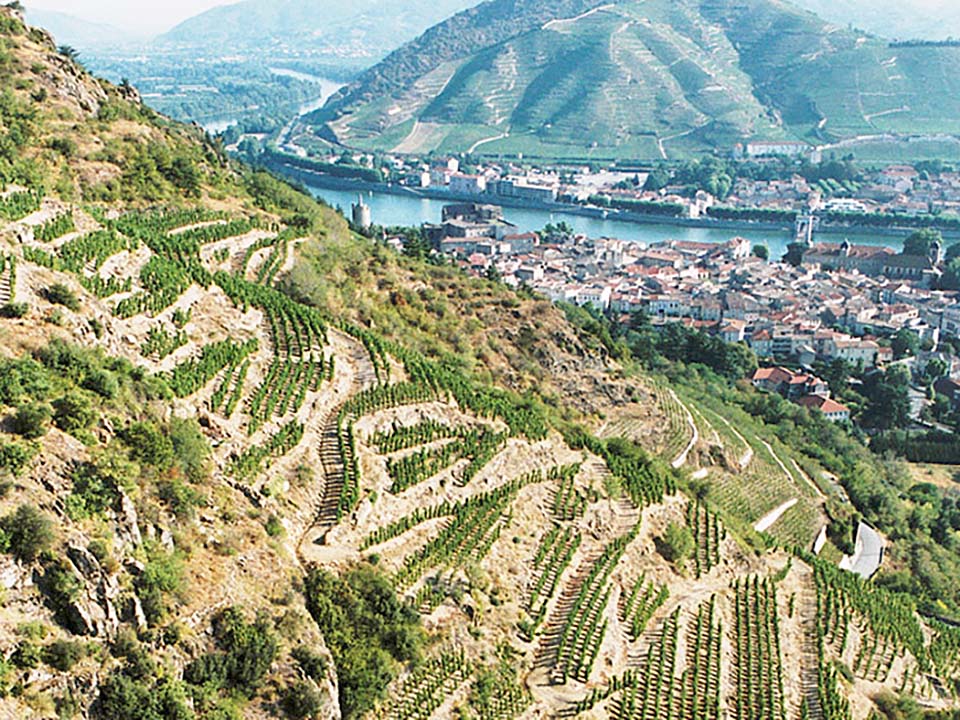
If you’re ever presented with a restaurant’s voluminous wine list of unfamiliar names, you can always play safe and request a Côtes du Rhône. Both the reds and whites from this region are relatively easy-drinkers and work well with food. Because the Côtes du Rhône is the second-largest wine region in France there is exceptional variety at all price points. The Rhône Valley takes its name from the river which rises in the Alps and makes its way south for about five hundred miles to the Mediterranean. It’s one of the great waterways of Europe and it’s been a lifeline since Greek and Roman times, being the main trade route from the Mediterranean to the heart of ancient Gaul. It’s also home to one of the oldest vineyard regions in the world. The name Côtes du Rhône (coat-duh-ROHN) means the “slopes” or “hills” of the Rhône and stretches over a hundred and fifty miles along both sides of the river between Lyon and Avignon, extending far into the surrounding fertile countryside.
The Rhône is divided into the North and South, which are quite separate regions about an hour’s drive apart. Their wines are completely different in style due to climatic conditions, the position of the vineyards in relation to the river, the nature of the soil and the grapes used. In the small, quality-driven Northern region, Syrah (often known elsewhere as Shiraz) is used almost exclusively for the reds. Here, Syrah reaches its height of expression and produces full bodied, savory and elegant wines. The white wines are made from Viognier, Marsanne and Roussane. In the enormous and sprawling region known as the Southern Rhône, Syrah is also used, but so are many other grapes. Syrah is usually blended with Grenache. Many reds are made from the Holy Trinity of Grenache, Syrah and Mourvèdre. Known as the GSM blend, these three varieties work blend well together that they’re used world-wide.
Now I don’t want to bore you comatose with technical stuff, but it’s important to know that there are four quality levels of Côtes du Rhône (or CDR as it’s known in the trade) and these impact on the price. Entry-level wines are labeled simply Côtes du Rhône and they’re easy-drinking and food-loving wines which account for nearly 70 percent of the region’s production. The next level upwards are labelled Côtes du Rhône Villages which are more complex wines. The third level are also labelled Côtes du Rhône Villages but the labels also state the name of the village. The fourth and top level wines are labeled Côtes du Rhône Cru and are from the best vineyards of the region. There are seventeen of these crus (or “growths”) and together they make about 20% of the total Rhône production. They include well-known names such as Beaumes des Venise, Châteauneuf-du-Pape, Hermitage and Côte-Rôtie.
Jeantet Côtes du Rhône AOP 2020 (red), France. Bt 750 @ Villa Market.
I plucked this wine off the shelf more-or-less at random. Well, not quite at random because I wanted a CDR and preferably one under Bt 800. It turned out to be a lucky choice. It’s a Southern Rhône and if you’ve been concentrating, you’ll know already that it’s an entry-level wine. It’s made from Syrah and Grenache, but in case you’re wondering about the “AOP” it stands for Appellation d’Origine Protégée, a designation introduced in 2009. It’s pretty much the same as the more familiar AOC (Appellation d’Origine Contrôlée) and refers to the French wine regulations covering vineyard and winery practices.
This wine comes from the Jeantet company, pronounced roughly like zhang-tay. For a more authentic French accent, hold your nose while you say it. An inviting dark crimson colour, the wine has a lovely soft aroma of spicy black fruit up-front, notably blackberry, plum and herbs. Maybe there’s a touch of black cherry too. It’s beautifully smooth on the palate with a light touch of acidity. It’s medium-bodied, with finely-grained velvety tannins, reasonably dry and has a long, firm dry finish. At a generous 14% ABV, this is a relatively simple but pleasing wine that would make an excellent partner for grilled beef filet or lamb dishes. Not being a person who eats either, I tried it with a lively-tasting cheese and onion dish and it worked perfectly. After resting in the carafe for about 45 minutes the tannins softened noticeably.
If you want to taste this wine at its best, be sure to get the serving temperature correct and give it time to breathe. I know I tend to harp on about this, but it really is important because even a few degrees too low can bring out unwelcome qualities in red wine. The makers suggest 16°-19° C which should feel slightly cooler than the ambient temperature. I usually put an empty carafe in the freezer for fifteen minutes then pour in the room-temperature wine. It’s a bit haphazard but seems to work.
To my mind this is a splendid example of an entry-level CDR; a smooth and dry easy-drinker that offers excellent value. I will certainly buy some more next time I visit Villa. But if the wine has all gone, I know who to blame and I shall never speak to you again.





